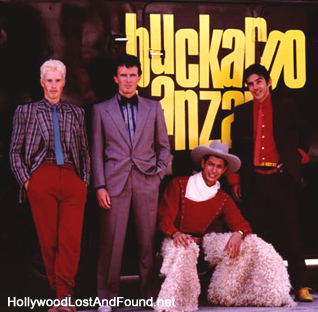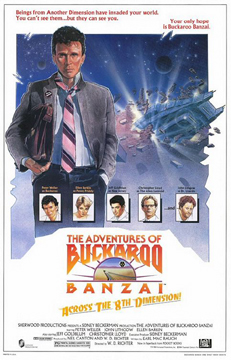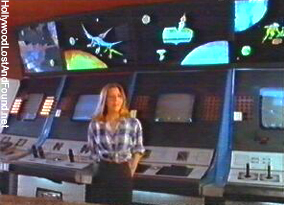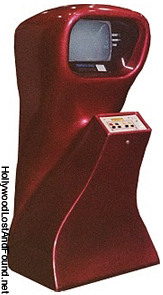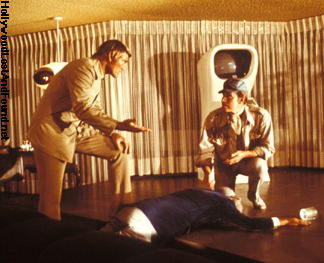Critics On A Plane
By Rick Mitchell
With apologies to Tom Hatten, Richard Schickel, and the late Arthur Knight, to whom the following doesn't apply anyway.
The title is obviously a pun, but it also reflects most critics' attitude toward their "audiences", that critics are on a higher aesthetic and intellectual plane than the "great unwashed." This attitude has become increasingly prominent over the last fifteen years with the rise to mainstream prominence of "holier-than-thou" critics from the alternative press, and the development of an industry attitude that has seen all types of films: arthouse, mainstream, and exploitation, lumped together and extolled or dismissed by the same standards.
Actually there apparently has never been an official standard for criticizing films, one that recognizes both the reality of the influence of technology and the filmmaking process on the resulting product, and in the context of the audience for which it was ultimately intended. Academics, and critics from that background, tend to base their opinions on standards drawn from literary criticism, yet, ironically, where film storytelling is actually closer to that of novels and especially short stories than plays, such critics usually lack the visual education to understand how a filmmaker like George Stevens, for example, uses images the way an author uses poetic verbal description. And of course, few films, especially commercial American ones, have never been considered on a par with the most pedestrian of literary works, except maybe Mickey Spillane.
How this conflict has played out with different levels of the public over the last forty years is exemplified by one of the few reader letters the Los Angeles Times printed in response to its articles on the subject. He wrote: "I don't want to read what the man or woman on the street thinks of films - they are the utterances of the uninformed. If you never heard of Fellini, haven't seen RASHOMON or don't know that Pride and Prejudice was a book before it was a film, I don't want to hear what you have to say about movies."
That elitist attitude is fine if you're writing or talking about Woody Allen's SCOOP, but references to Fellini and Kurosawa in reviews of INVINCIBLE or ACCEPTED? Elitist probably wouldn't even read or listen to reviews of those films, while the general public wouldn't know what the critic was talking about, even if the editors allowed such comments to get through. And, as always, the comments of peers, even ones they don't know, but whom moviegoers feel think like them, do count more, especially for so-called low brow fare.

As a result, film critics are feeling the downside of forty years of hubris, what with audiences rejecting their opinions of THE DA VINCI CODE and PIRATES OF THE CARIBBEAN: DEAD MAN'S CHEST and, in the wake of a number of low budget exploitation films opening successfully without advance reviews, New Line Cinema giving them the ultimate middle finger salute by deliberately opening the very high profile SNAKES ON A PLANE without screening it for them. Overlooked in all this, of course, is the fact that critics have never kept audiences away from films that adroit publicity had created a strong desire to see, especially the low budget exploitation horror, science-fiction, and action films of the Fifties through Eighties. (And Sony was foolish not to fight that lawsuit over "bogus" review snippets in an ad!)
Undiscussed in the ongoing contretemps is that this cultural snobbery, critics and their more upscale readers versus the general public, has always existed with regard to motion pictures, as well as other forms of popular entertainment introduced in the 20th Century, especially from the United States. Outside of New York City, film critics have actually had very little influence or importance prior to the mid-Sixties. Though there were a few critics, like Vachel Lindsay, who took motion pictures seriously, most English critics, and the American critics who took their cultural cues from them, looked down on the upstart medium, treating it at best as a bastard form of theater, even after it found its voice, rather than a unique narrative medium in its own right. As film advertising became an important source of revenue for New York papers, they began assigning second stringers to review them, usually favorably if it was a major release. This fed into the desire for social acceptance of the medium by filmmakers, and by extension, social acceptance for social climbing moguls like Louis B. Mayer. Lesser films, like westerns and comedies, were routinely ignored. The industry's subsequent change in attitude can be traced to the higher level of education of industry executives and filmmakers who emerged in the Fifties. Most had been educated in East Coast liberal arts colleges which placed a high degree of importance on critical opinion when evaluating artistic works, whether informed or not.
Beginning in the late Forties, the popularity of foreign films with advertising campaigns based around critical quotes naturally led to American producers and directors wanting similar campaigns for their films, a notable exception being Woody Allen, at the time when he was considered the greatest American filmmaker by the New York critics. And since the roadshow films of the Fifties and Sixties were considered the cinematic equivalent of great stage presentations, critical quotes were considered a major aspect of their publicity campaigns, the trailer for the general release of AROUND THE WORLD IN EIGHTY DAYS (1956) being a perfect example, since its producer, Mike Todd, had essentially invented the idea of tying roadshow presentation with unique cinematic technologies like Cinerama and Todd-AO.
At the same time, from the exploitation depths came the classic circus ballyhooing of films like BWANA DEVIL (1952) and THE BEAST FROM 20,000 FATHOMS (1953) which reached new heights in the work of American International publicist Julian Myers, who'd also been the publicist for 20th Century-Fox's CinemaScope. Of course, films like THE FLY and THE BLOB (both 1958), William Castle's films for Allied Artists and Columbia, and AIP's HOUSE OF USHER (1960) were automatically critic-proof.
These were the type of films to which I'd been exposed in the cultural desert of Lexington, KY, usually negatively reviewed on the rare occasion they were. Of course the films noir, noirish westerns and many of the horror and science-fiction Bs of the period are now considered classics of cinema while most of the gushingly critically extolled As of the period are forgotten. Ironically, the former films were started up the path to classic status by French critics from Cahier du Cinema and similar publications.
One might think that given this precedent, critics of the so-called film generation would be more charitable toward moderate-to-low budget genre films, especially given their filmmakers' freedom to deal with social and intellectual issues that weren't often allowed in big budget films. To be fair, some mainstream critics like the above mentioned Messrs. Knight and Schickel (Mr. Hatten wasn't reviewing in the Sixties and Seventies), as well as the late Art Murphy of Variety and Charles Champlin of the L.A. Times, were charitable toward the more deserving of such films when they were assigned to cover them. It was the critics from the underground press who were most offended by the very existence of films with titles like ANGELS HARD AS THEY COME, BLACULA, and WEREWOLVES ON WHEELS, much less having to sit through and review them.
Though this attitude has tempered somewhat (the LA Weekly's Scott Foundas gave SNAKES ON A PLANE one of its most positive reviews), especially when a genre filmmaker promotes himself into cult status, like Quentin Tarantino, films are still critically evaluated as if they are offshoots of live theater. Earlier this year, in a segment of KPCC's 'Air Talk' program devoted to the upcoming Oscars, all five of the critics on the program gushed about the performance of the Best Supporting Actress nominee for BROKEBACK MOUNTAIN as if she, to paraphrase Billy Wilder, et.al. "made it up as they went along", without any input from the director or acknowledgement of what happened in the editing room. (To follow a film from dailies to answer print would be a real shock for most critics, and not a few studio executives!)
Genre films, which are the bone of contention in this whole argument, especially the more mainstream type, rather than arthouse hybrids like THE ILLUSIONIST, cannot be evaluated like plays, because they are not just about acting, but equally about the contributions of the production and costume designers, cinematographers, picture and sound editors, composers, and dubbing mixers. Many films which have less than intelligent scripts and less than stellar performances ultimately work because of the contribution of these cinematic elements to the totality of the work, especially on some of the more ambitious low budgeters like THE TIME TRAVELERS (1964).
I've always felt that films should be evaluated based on their intended audience, "low brow" fare reviewed from the viewpoint of their intended audience, even when the reviews appeared in newspapers or other mainstream media. There was at least one critic who seriously attempted this, the L.A. Times' Kevin Thomas. As the paper's second stringer, he was usually assigned such films, and living in downtown L.A. in the late Sixties and Seventies, he chose to actually see such films with their intended audiences, until he was mugged. His initial reviews compared the new films with others of the type and included references to relevant older, and occasionally even foreign genre films, and his comments were often affected by audience response. Unfortunately his Don Quixote stance went to his head as he was actually courted by filmmakers and distributors of low budget genre films, and his credibility went out the window when he found something positive to say about everything he saw, even if the target audience considered it a dollop of dung. Mr. Thomas still reviews one or two low-budgeters a week for the Times, but with more objectivity.
As it happened, SNAKES ON A PLANE, despite its ultimately majority positive reviews, was not the expected megahit and had a 50% dropoff in attendance in its second week, as usual no one noting that 95% of such films have been one weekend phenomenona over the last 50 years, long before films opened in 3,000 theaters. Because of the type of film it is, this "failure" is not likely to be used as an example supporting the importance and relevance of film critics. But the overall issue does suggest that a reassessment of the importance of critics when it comes to films aimed at the mainstream audience, especially the 12-24 year old set.
©2006 Rick Mitchell. Universe rights reserved.
The title is obviously a pun, but it also reflects most critics' attitude toward their "audiences", that critics are on a higher aesthetic and intellectual plane than the "great unwashed." This attitude has become increasingly prominent over the last fifteen years with the rise to mainstream prominence of "holier-than-thou" critics from the alternative press, and the development of an industry attitude that has seen all types of films: arthouse, mainstream, and exploitation, lumped together and extolled or dismissed by the same standards.
Actually there apparently has never been an official standard for criticizing films, one that recognizes both the reality of the influence of technology and the filmmaking process on the resulting product, and in the context of the audience for which it was ultimately intended. Academics, and critics from that background, tend to base their opinions on standards drawn from literary criticism, yet, ironically, where film storytelling is actually closer to that of novels and especially short stories than plays, such critics usually lack the visual education to understand how a filmmaker like George Stevens, for example, uses images the way an author uses poetic verbal description. And of course, few films, especially commercial American ones, have never been considered on a par with the most pedestrian of literary works, except maybe Mickey Spillane.
How this conflict has played out with different levels of the public over the last forty years is exemplified by one of the few reader letters the Los Angeles Times printed in response to its articles on the subject. He wrote: "I don't want to read what the man or woman on the street thinks of films - they are the utterances of the uninformed. If you never heard of Fellini, haven't seen RASHOMON or don't know that Pride and Prejudice was a book before it was a film, I don't want to hear what you have to say about movies."
That elitist attitude is fine if you're writing or talking about Woody Allen's SCOOP, but references to Fellini and Kurosawa in reviews of INVINCIBLE or ACCEPTED? Elitist probably wouldn't even read or listen to reviews of those films, while the general public wouldn't know what the critic was talking about, even if the editors allowed such comments to get through. And, as always, the comments of peers, even ones they don't know, but whom moviegoers feel think like them, do count more, especially for so-called low brow fare.

As a result, film critics are feeling the downside of forty years of hubris, what with audiences rejecting their opinions of THE DA VINCI CODE and PIRATES OF THE CARIBBEAN: DEAD MAN'S CHEST and, in the wake of a number of low budget exploitation films opening successfully without advance reviews, New Line Cinema giving them the ultimate middle finger salute by deliberately opening the very high profile SNAKES ON A PLANE without screening it for them. Overlooked in all this, of course, is the fact that critics have never kept audiences away from films that adroit publicity had created a strong desire to see, especially the low budget exploitation horror, science-fiction, and action films of the Fifties through Eighties. (And Sony was foolish not to fight that lawsuit over "bogus" review snippets in an ad!)
Undiscussed in the ongoing contretemps is that this cultural snobbery, critics and their more upscale readers versus the general public, has always existed with regard to motion pictures, as well as other forms of popular entertainment introduced in the 20th Century, especially from the United States. Outside of New York City, film critics have actually had very little influence or importance prior to the mid-Sixties. Though there were a few critics, like Vachel Lindsay, who took motion pictures seriously, most English critics, and the American critics who took their cultural cues from them, looked down on the upstart medium, treating it at best as a bastard form of theater, even after it found its voice, rather than a unique narrative medium in its own right. As film advertising became an important source of revenue for New York papers, they began assigning second stringers to review them, usually favorably if it was a major release. This fed into the desire for social acceptance of the medium by filmmakers, and by extension, social acceptance for social climbing moguls like Louis B. Mayer. Lesser films, like westerns and comedies, were routinely ignored. The industry's subsequent change in attitude can be traced to the higher level of education of industry executives and filmmakers who emerged in the Fifties. Most had been educated in East Coast liberal arts colleges which placed a high degree of importance on critical opinion when evaluating artistic works, whether informed or not.
Beginning in the late Forties, the popularity of foreign films with advertising campaigns based around critical quotes naturally led to American producers and directors wanting similar campaigns for their films, a notable exception being Woody Allen, at the time when he was considered the greatest American filmmaker by the New York critics. And since the roadshow films of the Fifties and Sixties were considered the cinematic equivalent of great stage presentations, critical quotes were considered a major aspect of their publicity campaigns, the trailer for the general release of AROUND THE WORLD IN EIGHTY DAYS (1956) being a perfect example, since its producer, Mike Todd, had essentially invented the idea of tying roadshow presentation with unique cinematic technologies like Cinerama and Todd-AO.
At the same time, from the exploitation depths came the classic circus ballyhooing of films like BWANA DEVIL (1952) and THE BEAST FROM 20,000 FATHOMS (1953) which reached new heights in the work of American International publicist Julian Myers, who'd also been the publicist for 20th Century-Fox's CinemaScope. Of course, films like THE FLY and THE BLOB (both 1958), William Castle's films for Allied Artists and Columbia, and AIP's HOUSE OF USHER (1960) were automatically critic-proof.
These were the type of films to which I'd been exposed in the cultural desert of Lexington, KY, usually negatively reviewed on the rare occasion they were. Of course the films noir, noirish westerns and many of the horror and science-fiction Bs of the period are now considered classics of cinema while most of the gushingly critically extolled As of the period are forgotten. Ironically, the former films were started up the path to classic status by French critics from Cahier du Cinema and similar publications.
One might think that given this precedent, critics of the so-called film generation would be more charitable toward moderate-to-low budget genre films, especially given their filmmakers' freedom to deal with social and intellectual issues that weren't often allowed in big budget films. To be fair, some mainstream critics like the above mentioned Messrs. Knight and Schickel (Mr. Hatten wasn't reviewing in the Sixties and Seventies), as well as the late Art Murphy of Variety and Charles Champlin of the L.A. Times, were charitable toward the more deserving of such films when they were assigned to cover them. It was the critics from the underground press who were most offended by the very existence of films with titles like ANGELS HARD AS THEY COME, BLACULA, and WEREWOLVES ON WHEELS, much less having to sit through and review them.
Though this attitude has tempered somewhat (the LA Weekly's Scott Foundas gave SNAKES ON A PLANE one of its most positive reviews), especially when a genre filmmaker promotes himself into cult status, like Quentin Tarantino, films are still critically evaluated as if they are offshoots of live theater. Earlier this year, in a segment of KPCC's 'Air Talk' program devoted to the upcoming Oscars, all five of the critics on the program gushed about the performance of the Best Supporting Actress nominee for BROKEBACK MOUNTAIN as if she, to paraphrase Billy Wilder, et.al. "made it up as they went along", without any input from the director or acknowledgement of what happened in the editing room. (To follow a film from dailies to answer print would be a real shock for most critics, and not a few studio executives!)
Genre films, which are the bone of contention in this whole argument, especially the more mainstream type, rather than arthouse hybrids like THE ILLUSIONIST, cannot be evaluated like plays, because they are not just about acting, but equally about the contributions of the production and costume designers, cinematographers, picture and sound editors, composers, and dubbing mixers. Many films which have less than intelligent scripts and less than stellar performances ultimately work because of the contribution of these cinematic elements to the totality of the work, especially on some of the more ambitious low budgeters like THE TIME TRAVELERS (1964).
I've always felt that films should be evaluated based on their intended audience, "low brow" fare reviewed from the viewpoint of their intended audience, even when the reviews appeared in newspapers or other mainstream media. There was at least one critic who seriously attempted this, the L.A. Times' Kevin Thomas. As the paper's second stringer, he was usually assigned such films, and living in downtown L.A. in the late Sixties and Seventies, he chose to actually see such films with their intended audiences, until he was mugged. His initial reviews compared the new films with others of the type and included references to relevant older, and occasionally even foreign genre films, and his comments were often affected by audience response. Unfortunately his Don Quixote stance went to his head as he was actually courted by filmmakers and distributors of low budget genre films, and his credibility went out the window when he found something positive to say about everything he saw, even if the target audience considered it a dollop of dung. Mr. Thomas still reviews one or two low-budgeters a week for the Times, but with more objectivity.
As it happened, SNAKES ON A PLANE, despite its ultimately majority positive reviews, was not the expected megahit and had a 50% dropoff in attendance in its second week, as usual no one noting that 95% of such films have been one weekend phenomenona over the last 50 years, long before films opened in 3,000 theaters. Because of the type of film it is, this "failure" is not likely to be used as an example supporting the importance and relevance of film critics. But the overall issue does suggest that a reassessment of the importance of critics when it comes to films aimed at the mainstream audience, especially the 12-24 year old set.
©2006 Rick Mitchell. Universe rights reserved.
